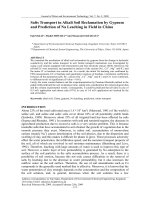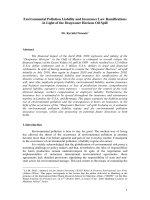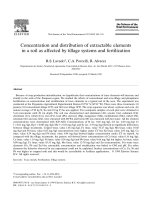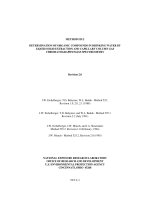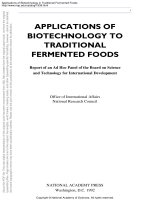- Trang chủ >>
- Khoa Học Tự Nhiên >>
- Vật lý
ethanol interference in light alkane sensing by metal-oxide solid solutions
Bạn đang xem bản rút gọn của tài liệu. Xem và tải ngay bản đầy đủ của tài liệu tại đây (728.81 KB, 5 trang )
Please cite this article in press as: M.C. Carotta, et al., Ethanol interference in light alkane sensing by metal-oxide solid solutions, Sens.
Actuators B: Chem. (2009), doi:10.1016/j.snb.2008.12.052
ARTICLE IN PRESS
G Model
SNB-11213; No. of Pages 5
Sensors and Actuators B xxx (2009) xxx–xxx
Contents lists available at ScienceDirect
Sensors and Actuators B: Chemical
journal homepage: www.elsevier.com/locate/snb
Ethanol interference in light alkane sensing by metal-oxide solid solutions
ଝ
M.C. Carotta
a
, A. Cervi
a,b
, A. Giberti
a
, V. Guidi
a,b,∗
, C. Malagù
a
, G. Martinelli
a,b
, D. Puzzovio
a,b
a
Department of Physics, University of Ferrara, Via Saragat 1/C, I-44100 Ferrara, Italy
b
INFN Section of Ferrara, Via Saragat 1/C, I-44100 Ferrara, Italy
article info
Article history:
Received 29 July 2008
Received in revised form 6 November 20 08
Accepted 15 December 2008
Available online xxx
Keywords:
Metal-oxide chemoresistive sensors
Light alkane detection
Ethanol interference
Active carbon filtre
abstract
A study of the sensing properties of chemoresistive metal-oxides vs. light alkanes has been undertaken
under wet condition and in presence of ethanol. Screen-printed films of a solid solution of mixed Sn and
Ti oxides have been selected for the purpose. We demonstrated that the films are capable of detecting
100 ppm of light alkanes or 500 ppm of methane in wet condition, two concentration levels by far lower
than their alarm thresholds, respectively. Ethanol is known to be a harmful interfering gas, though its
concentration can be reduced to values lower than 10 ppm by proper filtering. We show that, even in
presence of 10 ppm of ethanol, the films steadily responded to alkanes.
© 2008 Elsevier B.V. All rights reserved.
1. Introduction
Many different fields are interested by light-alkane detection.
Methane and propane have long been recognized for their use in
combustion, whilepropane can also be employed to produce hydro-
gen by steam-reforming plants. Detection of charged particles in
nuclear physics employs i-butane in gas-flow chambers. Therefore,
many studies regarding a selective sensor system have been carried
out in order to detect the presence and, ultimately, the leakages of
these gases.
Chemoresistive metal oxides are useful materials for alkane
detection due to their established advantages such as low cost,
compactness and ease of implementation with integrated-circuit
technology. Some results in alkane detection via chemoresistive
materials have been published [1–4] and systematic studies have
been carried out under dry and wet conditions [5,6]. However, oper-
ation of a sensor in real situations does demand the analysis of
the response in the presence of interfering gases, such as ethanol.
Indeed, the interference of ethanol is a well-known disturbance
in gas detection especially in domestic applications. In a previous
work we demonstrated that, under wet condition, the OH-group
of water competes in interaction with the active centres of alkane
interaction (i.e. the surface sites where atmospheric oxygen species
are adsorbed) [5]. Since the OH-group of ethanol is by far more reac-
ଝ
Paper presented at the International Meeting of Chemical Sensors 2008 (IMCS-
12), July 13–16, 2008, Columbus, OH, USA.
∗
Corresponding author at: Department of Physics, University of Ferrara, Via Sara-
gat 1/C, I-44100 Ferrara, Italy. Tel.: +39 0532974284; fax: +39 0532974210.
E-mail address: (V. Guidi).
tive than that of water, we expect an even stronger interference. A
possible solution to circumvent the presence of ethanol is the use of
an active carbon filtre, installed upstream the test chamber. The fil-
tre is capable of reducing the concentration of ethanol [7] to values
lower than 10 ppm as experimentally observed.
In this paper, we analyse the responses to light alkanes under
wet condition with and without 10 ppm of ethanol and critically
investigate the interference of the latter in the responses to alkanes.
2. Experimental
2.1. Sensing element preparation
We performed a series of measurements with most traditional
materials, such as SnO
2
and TiO
2
, together with their mixed oxides.
Such mixed oxides are as stable as SnO
2
, though they often exhibit
superior performance as shown in Ref. [5].
The sol–gel technique was used for preparation of the SnO
2
powder. A given amount of deionized water was added drop-wise
to n-butanol solution 0.7 M of tin(II)2-ethylexanoate, stirring it at
room temperature for 3 h. The molar ratio of water to Sn was 4 and
the pH of the solution was set at the unity with HNO
3
. The resulting
gel was dried at 95
◦
C for 12 h in order to obtain a yellow powder,
which was subsequently calcined at 550
◦
Cfor2h[8].
Titanium butoxide (TB) was used as a source of titanium to syn-
thesize the TiO
2
. TB dissolved in the absolute ethanol (0.23 M) was
added drop by drop to a solution of ethanol/water 1:1 vol under
mild stirring. This step was followed by 20 min of vigorous stirring.
The obtained suspension was treated by means of the sol–gel pro-
cess. After stirring, 16 h resting followed the suspension was filtered
0925-4005/$ – see front matter © 2008 Elsevier B.V. All rights reserved.
doi:10.1016/j.snb.2008.12.052
Please cite this article in press as: M.C. Carotta, et al., Ethanol interference in light alkane sensing by metal-oxide solid solutions, Sens.
Actuators B: Chem. (2009), doi:10.1016/j.snb.2008.12.052
ARTICLE IN PRESS
G Model
SNB-11213; No. of Pages 5
2 M.C. Carotta et al. / Sensors and Actuators B xxx (2009) xxx–xxx
Table 1
Lower and upper explosive limits for each alkane.
Alkane LEL (ppm) UEL (ppm) Density (air = 1)
CH
4
50,000 150,000 0.60
C
2
H
6
31,000 124,500 1.00
C
3
H
8
21,000 101,000 1.60
C
4
H
10
18,600 84,100 2.10
to obtain a white precipitate, which was dried in air (100
◦
C) for 16 h.
Finally, the powders were calcined at 400
◦
Cinairfor2h[9].
The solid solutions of Sn and Ti mixed oxide were produced
via symplectic gel coprecipitation (SGC) of stoichiometric Sn(4+)
and Ti(4+) hydroalcoholic solutions and further calcination of the
resulting xerogels. Calcination was performed at 550
◦
Cfor2h
under air flow condition. The obtained powders resulted in a
particle-size distribution averaging about 20 nm, as determined by
SEM [10]. The solid solution of Ti
x
Sn
1−x
O
2
with two values of x
(x = 0.3 and 0.5) will be hereinafter labeled as ST30 and ST50. Nb
was added to the pure solution of ST30 by coprecipitation, in the
proportion of Sn:Ti:Nb = 100:42:5 in order to enhance the conduc-
tivity.
The synthesized powders were mixed together with ␣-
terpineol, ethyl-cellulose and 2(2-butoxyethoxy) ethyl acetate in
order to obtain the serigraphyc paste. Then, this paste was screen-
printed onto miniaturized laser pre-cut alumina equipped with
a heater on the backside, a Pt-100 resistor controlling sensor
operating temperature and a golden front interdigitated contact.
Successively, firing was performed for 1 h at 650
◦
C under air flow
condition, resulting in 20–30 m film thickness [8].
2.2. Measurement of gas response
Film conductance was measured by the gas-flow technique in
a sealed test chamber. The sensor is inserted in an electric circuit,
equipped with an inverting operational amplifier, thus its transfer
function is
V
S
=−
R
C
R
S
V
B
(1)
where V
B
is the bias tension (set at −5 V), R
C
the feedback resis-
tance and R
S
is the resistance of the sensor. Voltage V
S
is measured
through the four-point method. Thus, the expression for the con-
ductance, G, holds
G =
1
R
S
=−
V
S
V
B
R
C
(2)
Finally, the response of the sensor is the ratio of the film conduc-
tance in gas and that in air (G
gas
/G
air
).
Relative humidity (RH) of the gas flow was monitored through
a HIH-3610-Series Honeywell humidity sensor. We operated with
wet (40% < RH < 50% at 25
◦
C) carrier. In this condition, a typical
resistance value for the sensing films is 10
11
at room tempera-
ture and 10
6
at about 500
◦
C. Alkanes and ethanol were supplied
by certified bottles and fe d into the test chamber at 500 cm
3
/min
total flow. In particular we chose: 100 ppm of C2–C4 alkanes and
500 ppm of methane because such values are by far lower than the
alarm levels (Table 1); 10 ppm of ethanol, because higher concen-
trations are prevented by the use of a filtre (NORIT RB1-activated
carbons), installed upstream the test chamber. Thus, we chose the
size of the filtre and the total flow in order to obtain a 99.9% filtering
efficiency and to obtain an estimated maximum of 5 ppm of ethanol
to be fed into the test chamber, when 5000 ppm were supplied.
Electrical measurements were performed at several operating tem-
peratures: within 300
◦
C and 650
◦
C. The ethanol filtre was tested
vs. 2500 ppm or 1670 ppm of methane and 5000 ppm of ethanol.
Fig. 1. Responses to 2500 ppm of CH
4
with and without filtre at 550
◦
C under wet
condition.
3. Results and discussion
We investigated first the behaviour of two films, SnO
2
and STN,
in the presence of an active carbon filtre at an intermediate temper-
ature (550
◦
C) under wet condition. The insertion of the filtre makes
the relative humidity decrease from about 45% down to about 25%
at 25
◦
C. In Fig. 1, we show the response of the films vs. 2500 ppm of
methane with and without the filtre. The response was found to be
higher with the filtre and the STN film turned out to be the best per-
forming sensor. According to the specifications of the manufacturer
of the filtre, absorption of methane by the filtre is negligible. The
response increases with the filtre on, because it reduces the inter-
ference of water in the reaction between methane and the film [5].
Fig. 2 shows the responses vs. 5000 ppm of ethanol and 1670 ppm
of methane with the filtre on, separately (a) and simultaneously
(b). In the latter, normalization is made relative to the conductance
achieved at a 5000 ppm of ethanol (with filtre on).
After testing the filtre, we carried out a set of systematic mea-
surements of the conductance of the sensors. Since a maximum
concentration of 5 ppm of ethanol can be released by the filtre,
we decided to perform all electrical measurements with 10 ppm
of ethanol and under wet condition, in order to overestimate any
possible interfering condition and to take into account of the active
carbon aging.
Ethanol was measured at temperatures within 300
◦
C and
650
◦
C, in order to estimate the extent of the response. The signal of
ethanol (see Fig. 3) initially increases with temperature then starts
decreasing at higher temperatures. Fig. 3 shows that the response
Fig. 2. Responses to 1670 ppm of CH
4
and 5000 ppm of C
2
H
6
O with filtre at 550
◦
C
under wet condition (a); responses to 1670 ppm of CH
4
in presence of 5000 ppm of
C
2
H
6
O (b).
Please cite this article in press as: M.C. Carotta, et al., Ethanol interference in light alkane sensing by metal-oxide solid solutions, Sens.
Actuators B: Chem. (2009), doi:10.1016/j.snb.2008.12.052
ARTICLE IN PRESS
G Model
SNB-11213; No. of Pages 5
M.C. Carotta et al. / Sensors and Actuators B xxx (2009) xxx–xxx 3
Fig. 3. Responses to 10 ppm of C
2
H
6
O at temperatures within 300
◦
C and 650
◦
C
under wet condition.
peaks at 400
◦
C for the SnO
2
layer and at 550
◦
C for the TiO
2
. The
other layers peak at intermediate temperatures. The behaviour of
ethanol is due to its favoured interaction with the sensor surface in
comparison to that of the alkanes, as it occurs with water [5]. The
oxidation of ethanol takes place on the surface of the sensor via the
dehydrogenation to acetaldehyde, involving the adsorbed oxygens
and the OH
−
group [11]:
O
ads
+ C
2
H
5
OH → CH
3
CHO + H
2
O (3)
First we focus on the electrical measurements achieved for alkanes,
then for alkanes in presence of ethanol. On the basis of the previ-
ous studies [5,6], the response vs. light alkanes is significantly high,
when operating above 450
◦
C. Figs. 4–6 show the responses vs. alka-
nes compared with that achieved for ethanol at temperature within
450
◦
C and 650
◦
C under wet condition. The STx and STN films
turned out to be the best performing sensors, while TiO
2
was too
resistive to appreciate the variations induced by gases. In general,
the response of the sensors vs. alkanes increases with the num-
ber of carbon atoms, and with temperature [5,6]. This behaviour is
explained through alkane oxidation via heterogeneous catalysis of
metal-oxide materials [12–14]. Very high- (over 1000
◦
C) and low-
temperature (400–700
◦
C) mechanisms are possible, though our
results are well explained by the low-temperature model [6]. The
first step consists of homolytic C–H bond breaking, which occurs
at the most reactive carbon atom of the chain. As a consequence,
Fig. 4. Response to 500 ppm of methane, 100 ppm of C2–C4 alkanes and 10 ppm of
C
2
H
6
Oat450
◦
C under wet conditions.
Fig. 5. Response to 500 ppm of methane, 100 ppm of C2–C4 alkanes and 10 ppm of
C
2
H
6
Oat550
◦
C under wet conditions.
O
−
species at surface (oxygen adsorbed on the sensor surface) trap
hydrogen and an alkyl radical is being created. In the second step,
the radical reacts to give a second homolytic C–H bond dissociation
and to form an alkene and a second OH
−
bond on the surface. In
the end, the whole process yields an alkene, which then proceeds
to oxidation of carbon to CO, CO
2
and cracking sub-products.
Finally, we investigated the interference of ethanol by measur-
ing the response of the sensors vs. alkanes under wet condition
within 450
◦
C and 650
◦
C. On the basis of the previous observations,
we expect that the SnO
2
layer sensitively responds to alkanes in
presence of ethanol at 650
◦
C, while the TiO
2
layer should be insen-
sitive and the other layers should respond similarly to the SnO
2
film. Indeed, we observed a negligible response below 550
◦
C and
significant sensing performance within 550
◦
C and 650
◦
C for all the
sensors (see Figs. 7 and 8). Ethanol lowered the response to alka-
nes, even if the sensors still sensitively detected such gases at high
temperatures. STN and SnO
2
turned out to be the best performing
films, especially at 650
◦
C.
All the electrical measurements are characterized by sensor
response and recovery times of about 10 min and 20 min, respec-
tively.
The present study demonstrates that it is possible to sensi-
tively detect alkanes in presence of a maximum concentration
Fig. 6. Response to 500 ppm of methane, 100 ppm of C2–C4 alkanes and 10 ppm of
C
2
H
6
Oat650
◦
C under wet conditions.
Please cite this article in press as: M.C. Carotta, et al., Ethanol interference in light alkane sensing by metal-oxide solid solutions, Sens.
Actuators B: Chem. (2009), doi:10.1016/j.snb.2008.12.052
ARTICLE IN PRESS
G Model
SNB-11213; No. of Pages 5
4 M.C. Carotta et al. / Sensors and Actuators B xxx (2009) xxx–xxx
Fig. 7. Response to 500 ppm of methane, 100 ppm of C2–C4 alkanes in presence of
10 ppm of C
2
H
6
Oat550
◦
C in wet conditions.
Fig. 8. Response to 500 ppm of methane, 100 ppm of C2–C4 alkanes in presence of
10 ppm of C
2
H
6
Oat650
◦
C in wet conditions.
of 10 ppm of ethanol under wet condition. In particular, the STN
and the SnO
2
films are suitable for this purpose at 650
◦
C. If the
concentration of ethanol were constant, it would be possible to
determine the concentration of alkanes through the knowledge of
the calibration curve. However, unexpected changes in the envi-
ronment or worsening of the filtre condition would change the
concentration of ethanol. In this case, an additional sensor capa-
ble of detecting specifically the concentration of ethanol is needed.
This device could either be the STN or the SnO
2
layer operat-
ing at maximum 400
◦
C. In fact, at this temperature, the films
proved to be insensitive to alkanes. When two interfering gases
are present, a two-dimension calibration surface is needed. This
surface is determined through the interpolation of several experi-
mental calibration curves of one gas. Each curve is built, fixing the
concentration of the second gas, according to the method in Ref.
[15]. In this case, the knowledge of the calibration curve of the film
sensitive to only ethanol and the calibration surface of the film sen-
sitive to alkanes and ethanol will lead to the concentration of the
alkane under consideration.
4. Conclusions
A study of the sensing properties of SnO
2
and TiO
2
-based oxides
vs. light alkanes has been undertaken under wet condition and in
presence of ethanol. We were able to considerably hinder the inter-
ference of ethanol and partly of humidity withan active carbon filtre
in a preliminary test. Positive indication regarding the development
of a device capable to detect light alkanes in presence of a max-
imum concentration of 10 ppm of ethanol have been determined
and a strategy for precise measurement of alkane concentration
has been highlighted.
Acknowledgments
This work has been partly financed by project DeGIMon by INFN
and by MIST-ER project by Regione Emilia Romagna.
References
[1] D. Kohl, L. Heinert, J. Bock, T. Hofmann, P. Schieberle, Systematic studies on
responses of metal-oxide sensor surfaces to straight chain alkanes, alcohols,
aldehydes, ketones, acids and esters using the SOMMSA approach, Sens. Actu-
ators B: Chem. 70 (2000) 43–50.
[2] D. Koziej, N. Bârsan, V. Hoffmann, J. Szuber, U. Weimar, Complementary phe-
nomenological and spectroscopic studies of propane sensing with tin dioxide
based sensors, Sens. Actuators B: Chem. 108 (2005) 75–83.
[3] D.P. Mann, T. Paraskeva, K.F.E. Pratt, I.P. Parkin, D.E. Williams, Metal oxide
semiconductor gas sensors utilizing a Cr-zeolite catalytic layer for improved
selectivity, Meas. Sci. Technol. 16 (2005) 1193–1200.
[4] S. Chakraborty, A. Sen, H.S. Maiti, Selective detection of methane and butane
by temperature modulation in iron doped tin oxide sensors, Sens. Actuators B:
Chem. 115 (2006) 610–615.
[5] M.C. Carotta, A. Cervi, A. Giberti, V. Guidi, C. Malagù, G. Martinelli, D. Puzzovio,
Metal-oxide solid solutions for light alkane sensing, Sens. Actuators B: Chem.
133 (2008) 516–520.
[6] V. Guidi, M.C. Carotta, G. Martinelli, M. Nagliati, D. Puzzovio, D. Vecchi, Sensing
of volatile alkanes by metal-oxide semiconductors, Sens. Actuators B: Chem.
130 (2008) 4 97–501.
[7] R. Mukundan, E.L. Brosha, F.H. Garzon, Applications of mixed potential sensors,
in: Electr. Digest, 12th Int. Meet. on Chemical Sensors, Columbus, OH, USA, July
13–16, 2008.
[8] A. Chiorino, G. Ghiotti, F. Prinetto, M.C. Carotta, D. Gnani, G. Martinelli, Prepara-
tion and characterization of SnO
2
and MoOx–SnO
2
nanosized powders for thick
film gas sensors, Sens. Actuators B: Chem. 58 (1999) 338–349.
[9] M.C. Carotta, S. Gherardi, C. Malagù, M. Nagliati, B. Vendemiati, G. Martinelli, M.
Sacerdoti, I.G. Lesci, Comparison between titania thick films obtained through
sol–gel and hydrothermal synthetic processes, Thin Solid Films 515 (2007)
8339–8344.
[10] M.C. Carotta, S. Gherardi, V. Guidi, C. Malagù, G. Martinelli, B. Vendemiati, M.
Sacerdoti, G. Ghiotti, S. Morandi, A. Bismuto, P. Maddalena, A. Setaro, (Ti, Sn)O
2
binary solid solutions for gas sensing: spectroscopic, optical and transport prop-
erties, Sens. Actuators B: Chem. 130 (2008) 38–45.
[11] V.S. Vaishnav, P.D. Patel, N.G. Patel, Indium tin oxide thin film gas sensors for
detection of ethanol vapours, Thin Solid Films 490 (2005) 94–100.
[12] H.H. Kung, Oxidative dehydrogenation of light (C2 to C4) alkanes, Adv. Catal. 40
(1994) 1.
[13] I.C. Marcu, J.M. Millet, J.M. Herrmann, Semiconductive and redox properties of
Ti and Zr pyrophosphate catalysts (TiP
2
O
7
and ZrP
2
O
7
). Consequences for the
oxidative dehydrogenation of n-butane, Catal. Lett. 78 (2002) 273–279.
[14] I.C. Marcu, J.M. Millet, I. Sandulescu, Oxidative dehydrogenation of isobutane
over a titanium pyrophosphate catalyst, J. Serb. Chem. Soc. 70 (2005) 791–798.
[15] A. Giberti, M.C. Carotta, V. Guidi, C. Malagù, G. Martinelli, M. Piga, B.
Vendemmiati, Monitoring of ethylene for agro-alimentary applications and
compensation of humidity effects, Sens. Actuators B: Chem. 103 (2004)
272–276.
Biographies
Maria Cristina Carotta became Doctor in physics at the University of Ferrara in 1973.
Since 1981 she has been researcher at the Department of Physics of the same Uni-
versity; she is also researcher within CNR-INFM (Department for the Physics of the
Matter within Research National Council). Since 1983 she has focused her research
activity on semiconductor physics, mainly on electrical, optical and transport prop-
erties of silicon and of semiconductor oxides for gas sensors. She is currently involved
in research projects concerning the development and characterization of nanostruc-
tured thick-film gas sensors for industrial and environmental applications.
Alan Cervi obtained master degree with honours in Nuclear and Subnuclear Physics
at the University of Ferrara in 2005. He is a Ph.D. student in Physics of Micro and
Nanotechnologies at the Physics Department of the University of Ferrara since 2006.
His research activity is mainly addressed to the characterization of nanostructured
metal oxides for gas sensing applications.
Alessio Giberti obtained bachelor in theoretical physics at the University of Ferrara
in 2000, and Ph.D. in physics of matter in 2004 at the Physics Department of the
University of Ferrara. His work since Ph.D. is focused on the field of semiconductor
Please cite this article in press as: M.C. Carotta, et al., Ethanol interference in light alkane sensing by metal-oxide solid solutions, Sens.
Actuators B: Chem. (2009), doi:10.1016/j.snb.2008.12.052
ARTICLE IN PRESS
G Model
SNB-11213; No. of Pages 5
M.C. Carotta et al. / Sensors and Actuators B xxx (2009) xxx–xxx 5
gas sensors based on nanostructured metal oxides, with particular interest toward
the electrical, transport and selectivity properties.
Vincenzo Guidi obtained bachelor in physics at the University of Ferrara in 1990,
and was a fellow at “Budker Institute for Nuclear Physics” of Novosibirsk (Russia)
in 1991. Thesis of doctorate was in experimental physics at Legnaro National Labo-
ratories in 1994. He is associate professor in experimental physics at University of
Ferrara. Research activity, carried out at the Sensors and Semiconductors Laboratory
of the University of Ferrara, has consisted of investigations on basic phenomena in
semiconductors and to practical implementations of sensing devices.
Cesare Malagù got bachelor in physics at the University of Ferrara in 1997 and his
Ph.D. in 2001 in experimental physics. He was Post doc with the National Institute of
Physics of Matter in 2001. His current research activity regards analytical modeling
of polycrystalline semiconductors. He is a lecturer at the University of Ferrara and
teaches general physics at the Department of Chemistry.
Giuliano Martinelli received his doctorate degree in physics at the University of
Ferrara (Italy) in 1968. Based at the Physics Department of the University of Ferrara
as an associate professor since 1980 and then as a full professor. His research interests
include silicon crystals growth, photovoltaic technology and thick-film gas sensors.
He coordinated several European projects both in P.V. and gas-sensor fields.
Delia Puzzovio received master degree in material science at the University of
Padova in 2005. She is a Ph.D. student in physics of matter at the Department
of Physics of the University of Ferrara since 20 06. Her research activity is mainly
addressed to the characterization of nanostructured metal oxides for gas sensing
applications.

